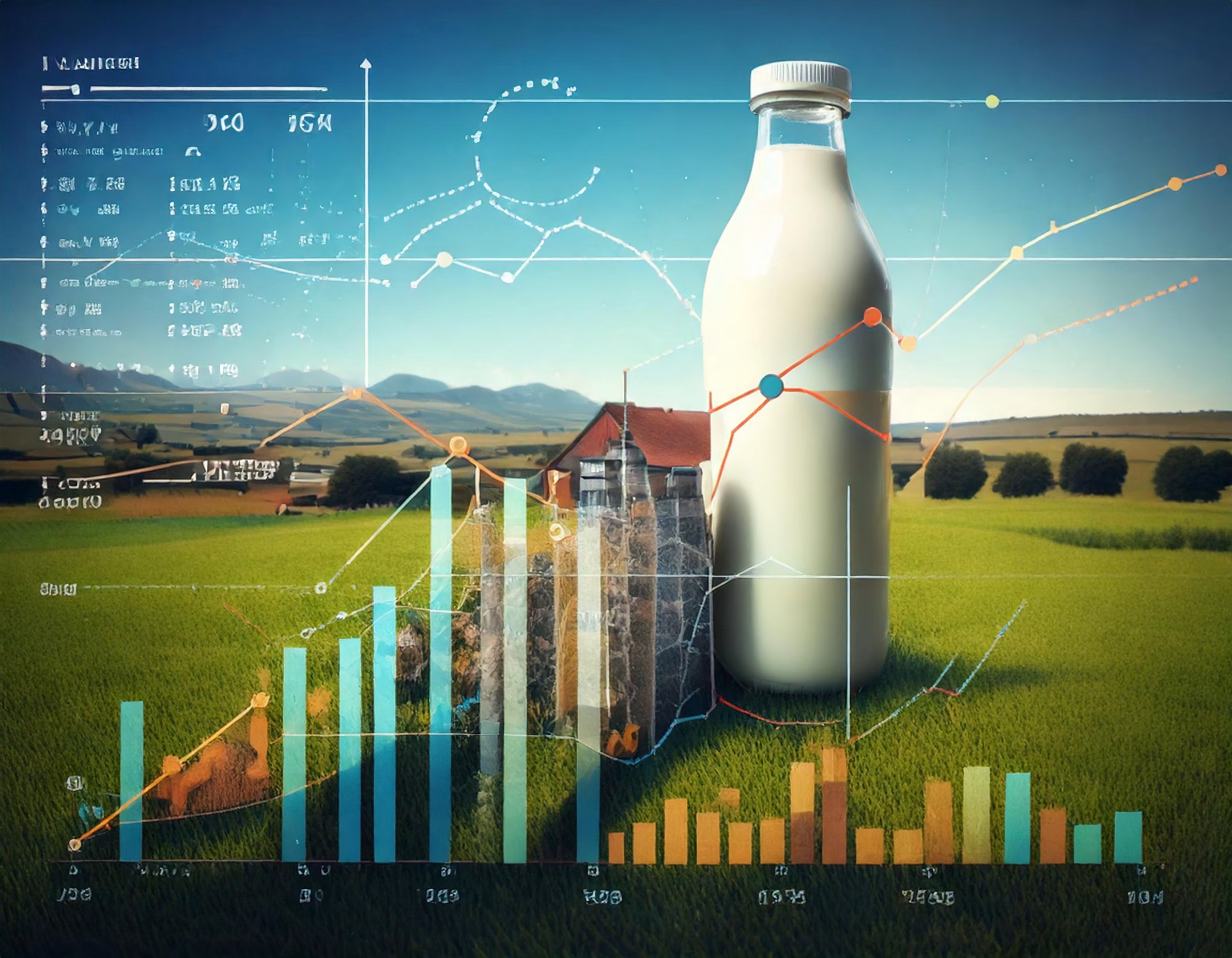Can a trade war with Mexico threaten US dairy? Explore expert views on impacts and strategies to protect your dairy business.
Summary:
The U.S. dairy industry faces a critical challenge from potential trade tensions with Mexico, a key purchaser of American dairy products, accounting for 25% of U.S. dairy exports valued at $5.5 billion last year. With 84% of Mexico’s dairy imports sourced from the U.S., retaliatory tariffs could slash farm-gate revenue by $16.6 billion, severely destabilizing the industry’s economic foundation. These tariffs have previously affected the competitiveness of U.S. dairy products, especially cheese and butter, making them more expensive in the Mexican market and leading to a noticeable decline in sales. Mexico remains an indispensable customer, purchasing one in four dairy products exported from the U.S. This precarious situation underscores the need for the U.S. dairy sector to remain vigilant regarding trade policy shifts and to advocate for strategies that safeguard and enhance market access, particularly in critical regions like Mexico.
Key Takeaways:
- A potential trade war with Mexico could severely impact the U.S. dairy industry, as Mexico is the largest importer of U.S. dairy products, accounting for 84% of its dairy imports.
- Tariffs and trade barriers previously affected farm-gate revenue, with similar tariffs projected to reduce it by $16.6 billion between 2018 and 2023.
- Consumer demand for butter is rising despite increased domestic production, with imports soaring to meet consumer preferences for high-butterfat European styles.
- A shift in Dairy farming trends shows a blending with beef farming; dairy replacements are at a two-decade low, highlighting a shift towards beef crossbreeding due to higher profits.
- Optimized use of gender-sorted semen and strategic planning is crucial for dairy farms seeking to expand or adapt to market demands.
- Low feed costs and a rise in consumer demand for high-quality protein products position the dairy industry potentially for a prosperous 2025. However, the ongoing concern remains tied to potential shifts in trade policies under a new administration.

Imagine waking up one morning to find that 25% of your most significant export market has disappeared overnight. This scary scenario could happen to the US dairy industry if a trade war with Mexico starts. Given that Mexico is the largest purchaser of American dairy products, any disruptions could result in significant financial losses for farms and jeopardize the livelihoods of numerous dairy farmers nationwide. The potential financial losses are staggering, and the urgency to address this issue is paramount. This industry’s stakes are incredibly high, and its success depends significantly on Mexico’s need for US dairy exports.
The Importance of Mexico to US Dairy: Mexico is a major buyer of US dairy products. The US Dairy Export Council reports that about 84% of Mexico’s dairy imports are from the US, accounting for approximately 25% of US dairy exports, valued at $5.5 billion last year. Losing this market would be a big problem for the US dairy industry.
Mexico: The Keystone of US Dairy Exports or Achilles’ Heel?
The difference between the US dairy trade and Mexico and China is evident when considering possible trade wars. About 84% of Mexico’s dairy imports come from the US, which means about 4.5% of all US milk production is sent to Mexico [source]. On the other hand, China buys less than 1% of dairy products from the US, making it a minor player in this market [source].
Based on these facts, a trade war with Mexico would hurt the US dairy industry much more than with China. US dairy farmers depend heavily on sales to Mexico, so any trade problems could be a big deal. Even though China is a big country, its low level of dairy imports from the US means a trade conflict wouldn’t affect us much.
Looking at past events helps us understand better. When tariffs were in place, the US Dairy Export Council found that tariffs on Mexican goods might have cut farm revenue by up to $16.6 billion from 2018 to 2023. However, tariffs on China didn’t affect the dairy business much [source]. Because the US relies on Mexico, trade problems could threaten our dairy industry.
During the first Trump administration, tariffs were a key change for the US dairy industry. These tariffs were introduced to fix trade issues with countries like Mexico and China. However, they caused significant problems, especially for businesses like Dairy that sell products overseas.
In 2018, the US Dairy Export Council found that tariffs on Mexican and Chinese goods could cut farm revenue by $16.6 billion through 2023. This figure underscores the heavy reliance of the US dairy industry on foreign trade. Due to this heavy reliance, particularly on exports to Mexico, where most dairy imports originate from the US, the dairy industry faces significant challenges. A disruption in this trade relationship, such as a trade war, could lead to a substantial decrease in farm revenue and threaten the stability of the entire industry.
When Mexico imposed tariffs on US products in return, these challenges worsened. This affected raw milk and processed foods like cheese and butter. The tariffs made US dairy products more expensive and less competitive in the Mexican market, causing a significant drop in sales. These financial challenges impacted the dairy business, affecting everything from the supply chain to the farmers, who saw a direct impact on their income and livelihood.
These tariffs affected more than just money. They forced the industry to rethink its export plans and highlighted the importance of good trade talks, considering the balance of selling and buying goods across countries. In the future, the US dairy industry needs to stay alert to changes in trade policies and push for policies that protect or grow its chances of selling in essential markets.
The Butter and Cheese Boom: A Double-Edged Sword in US Dairy Dynamics
The current state of the US dairy market shows a significant demand for butter and cheese, indicating a change in consumer preferences. Despite past arguments about its health effects, butter has become popular again, with record-breaking US production. Cheese is also being eaten more, making it the top choice in dairy products. However, this high demand could be affected by international trade issues.
If a trade war with Mexico occurs, it could have a significant impact. Butter and cheese exports help balance what’s made in the US with global needs. Any problems in this trade could lead to too much supply in the US. Mexico is a key buyer of US dairy exports. If tariffs are implemented, these products might flood the local market and not have enough demand.
This potential oversupply could lead to price drops. Dairy producers may face challenges when new production levels and strong consumer interest are affected by political issues. This situation calls for careful planning from everyone involved, pushing them to look beyond Mexico for business and use risk management strategies like forward contracts and hedging to protect against financial problems. Forward contracts and hedging allow dairy farmers to lock in prices for their products or inputs, protecting their income from market fluctuations.
Breeding Dilemma: The Double-Edged Sword of Beef-Dairy Crosses and Dairy Replacement Shortages
Today, US dairy producers face significant challenges, such as the shortage of dairy replacements and the growing popularity of beef-dairy crosses. These issues make it difficult for the industry to adjust to changing markets.
This shortage of dairy replacements is a serious problem, making it challenging for the industry to expand or maintain current production levels. The shortage is mainly due to fewer dairy cows being kept, and more farmers prefer beef-dairy crosses, which immediately bring in more money. This shift has made it hard to find enough purebred dairy calves.
The effects of this situation are enormous, casting a long shadow over the future of the US dairy industry. The choice by many farmers to prioritize more valuable beef-dairy crosses over traditional dairy replacements is creating a daunting supply gap. This trend, driven by short-term financial incentives, could lead to a significant contraction in milk production capabilities. Unfortunately, resolving these issues is neither quick nor inexpensive. Rebuilding herds to meet demand involves time and substantial financial investment, pushing farmers into a precarious position where rapid adaptation to market fluctuations becomes nearly impossible.
This lack of replacement heifers makes it harder for the industry to keep up with changing consumer needs or new export opportunities. To address these problems, the US dairy sector needs good planning to manage immediate pressures and ensure future growth and stability.
Navigating the Storm: Strategic Planning as Dairy’s Lifeline
Making innovative plans could help dairy farmers handle possible trade issues in these uncertain times. By locking in feed prices, farmers can protect their profits from changes in market trends. Right now, low prices for corn and soybean meal offer a good chance for farmers to fix their feed costs and protect their income.
Finding new markets is also a smart move that could reduce the effects of possible trade barriers. Offering various dairy products, such as advanced cheese and whey protein, can create new opportunities and lower risks linked to depending too much on certain trade partners. Farmers and dairy businesses might consider boosting their marketing in fast-growing areas or even at home, where demand for new dairy products like high-protein supplements is rising.
However, diversification extends beyond products to encompass markets, underscoring the holistic approach needed for strategic growth in the dairy industry. Diversifying trade relationships and entering new markets helps the dairy industry reduce the impact of market fluctuations or political changes in any single market. This strategy requires good strategic planning and studying new markets, but it can strengthen the industry against global changes.
Strategic planning is crucial for the future success of the US dairy industry. As we look towards 2025, being quick to adapt can make the difference between doing well and just getting by if a trade war happens. While political situations change and economic conditions vary, businesses focusing on planning will be best positioned to succeed.
The Bottom Line
The US dairy industry is at a critical crossroads. The trade relationship with Mexico is crucial as 84% of Mexico’s dairy imports originate from the US. Therefore, we need to think about our trade policies carefully. One example of how tariffs have previously affected farm income in the dairy industry is the analysis by the US Dairy Export Council on the tariffs during past trade tensions with Mexico and China. These tariffs, ranging from 25% to 27.5% on US dairy exports, had a substantial financial impact, potentially reducing farm-gate revenue by up to $16.6 billion by 2023. For instance, when tariffs were put on cheese exports to Mexico during the first Trump administration, it led to a drop in demand, which meant less income for US farmers from one of their biggest foreign customers. Furthermore, retaliatory tariffs from China severely affected exports of whey products and milk powders, essential parts of US dairy exports. These examples show how trade policy can directly impact farm income, as tariffs block export routes and cut potential earnings that dairy farmers depend on [USDA Economic Research Service].
While demand for butter and cheese is rising at home, it also brings problems, especially with a shortage of dairy cows to replace older ones. Understanding the potential impacts of disputes and tariffs on global trade is crucial for comprehending their effects on the market and people’s daily lives. The ongoing battle between beef and Dairy farming makes things even more complicated. How will you handle these changes as dairy professionals? These challenges also bring opportunities to create new ideas and support policies that protect jobs. Working with lawmakers, understanding global markets, and careful planning could be part of the solution. Taking decisive action and making meaningful contributions is imperative to drive positive change in the dairy industry.
Learn more:
- American Dairy Farmers Grapple with Trade War and Immigration Policies: The Fight to Stay Afloat
- North American Dairy Trade: US-Mexico Relations Strengthen Amid Canada’s Growing Trade Tensions
- U.S Dairy Industry Pushes for Enhanced Trade Policies to Boost Exports and Strengthen Supply Chain
 Join the Revolution!
Join the Revolution!
Bullvine Daily is your essential e-zine for staying ahead in the dairy industry. With over 30,000 subscribers, we bring you the week’s top news, helping you manage tasks efficiently. Stay informed about milk production, tech adoption, and more, so you can concentrate on your dairy operations.







 Join the Revolution!
Join the Revolution!





